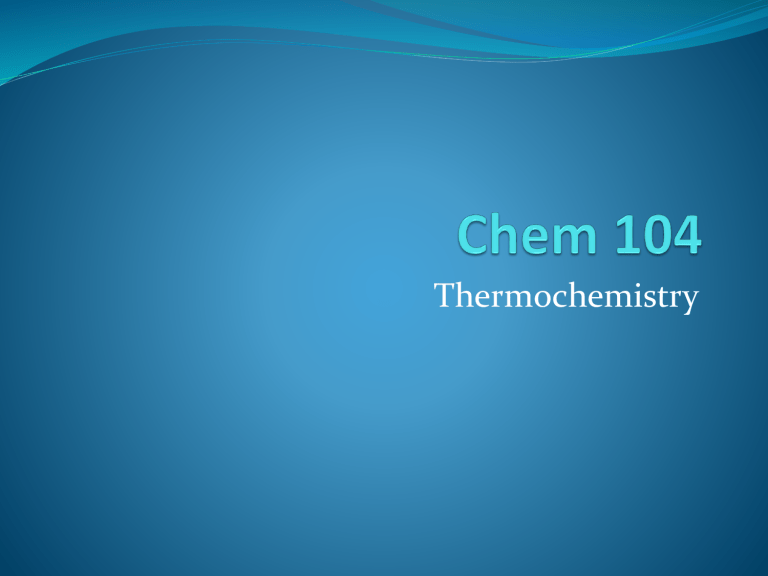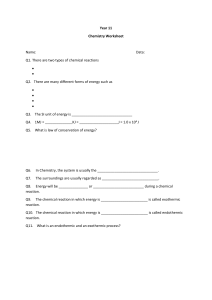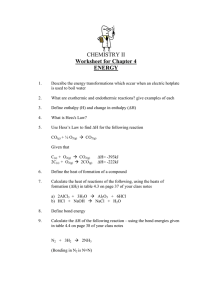
Thermochemistry The Nature of Energy Energy is defined as the ability to do work (a force exerted over a distance) or produce heat. Types of Energy -- Kinetic Energy – is the energy of motion (KE = ½ mv2). There are three kinetic energies associated with the states of matter. Vibrational motion – is the bond bending and stretching of molecules in the solid state. As the temperature of the solid approaches the melting point of the pure substance the vibrational motion or energy increases. Rotational motion – is the tumbling of molecules in the liquid phase of matter. This energy is gained when the solid completely melts. As the temperature of the liquid approaches the boiling point the rotational motion of the pure substance increases. In the liquid phase the pure substance has both vibrational and rotational motion. Translational motion – is straight-line motion. This energy is gained when the pure substance completely vaporizes (liquid to gas phase). As the temperature of the gas increases the translational motion increases. A gas has vibrational, rotational and translational energy or motion. The Nature of Energy Potential Energy – is energy due to position or composition. Chemical potential energy – energy due to composition. Energy that is stored in the bonds of the substance. (CPE) Gravitational potential energy – energy due to position. (GPE = mgh) Conservation of Energy -- states that energy can be converted from one form to another but can be neither created nor destroyed. THE ENERGY OF THE UNIVERSE IS CONSTANT. The Nature of Energy ENERGY CHANGE IS INDEPENDENT OF THE PATHWAY, WHEREAS WORK AND HEAT ARE BOTH DEPENDENT ON THE PATHWAY. State Function – is a property of the system that changes independently of its pathway. A trip from Chicago to Denver; the distance travelled is not a state function while the elevation is a state function. In varying the surface of a hill from very smooth to very rough a ball always loses the same amount of energy because of its position. The way that this energy transfer is divided between work (w) and heat (q), however, depends on the specific conditions – the pathway. If more energy is expended (due to the surface being rough, frictional heating is higher) less work is done on the ball. If less energy is expended (due to the surface being smooth, frictional heating is lower) more work is done on the ball. The Nature of Energy Temperature and Heat Temperature – is the measure of the average kinetic energy of all the molecules. The kinetic energy of warm water has the water molecules moving around more rapidly than the water molecules in cold water. Heat – is the flow of energy due to a temperature difference. Energy will always flow from the warmer substance (higher temperature) to the cooler substance (colder temperature). Because the energy is constant the energy lost by the warmer substance is equal to the energy gained by the cooler substance (assuming no energy is lost to the environment). Mathematically: Energy Lost (EL) = Energy Gained (EG) - EL = EG System Vs Surroundings To consider energy changes that accompany chemical reactions, definitions of system and surrounding have to be established. The SYSTEM is part of the universe on which we wish to focus attention, the reactants and products of the reaction. The SURROUNDINGS include everything else in the universe, the air in the room and anything else other than the reactants and products. System Vs Surroundings Sodium hydroxide dissolved in water in a beaker. System --Surroundings -- Methanol is ignited in a 20.0 litre container. System --Surroundings --Aluminum and iodine reaction (in an evaporating dish) is sped up by the addition of a water. System --Surroundings --- Exothermic Vs Endothermic Exothermic – this is a process that results in the evolution of heat (exo- meaning ‘out of’). The burning of a match, energy in the form of heat flows out of the system. Endothermic – this is a process that absorbs energy from the surroundings (endo –meaning within, inner). The evaporation of water from a pond or a lake has energy in the form of heat being absorbed from the air surrounding the pond or lake. Diagram -- Exothermic Diagram – Endothermic Thermodynamics The study of energy is called thermodynamics. The law of conservation of energy is often called the first law of thermodynamics – the energy of the universe is constant. The internal energy (E) of a system is the sum of all the kinetic and potential energies of all particles in the system. The internal energy (E) of the system can be changed by a flow of work, heat or both. E = q + w = means a change in the internal energy q = represents heat w = represents work Thermodynamics quantities consist of a number (indicating magnitude) and a sign (+, -) indicating the direction of flow. THE SIGN REFLECTS THE SYSTEMS POINT OF VIEW. Heat Vs Work HEAT If energy flows into the system in the form of heat (endothermic) ‘q’ equals a ‘+x’, the positive sign indicates the energy of the system is increasing. When energy flows out of the system in the form of heat (exothermic) then ‘q’ is a ‘–x’, where the negative sign indicates that the system’s energy is decreasing. WORK If the system does work on the surroundings (energy flows out of the system), ‘w’ is negative. If the surroundings do work on the system (energy flows into the system), ‘w’ is positive. Change in Internal Energy (ΔE) Calorimetry Measuring Energy Changes The units for energy measurement are the calorie and the joule. In the metric system the calorie is the amount of energy (heat) required to raise the temperature of one gram of water by one degree Celsius. The calorie which is used to measure the energy content of food is actually the kilocalorie (1000 calories) written with a capital C. The joule (J) is defined in terms of the calorie used in chemistry 1 cal = 4.184 J Calorimetry – Determining Energy Content Energy is dependent of the mass of a substance the greater the mass of the substance the more energy it contains, thus energy is proportional to the mass. Energy is also dependent of the temperature change of the substance the greater the temperature change the more energy the substance contains thus energy is proportional to the temperature change. Energy mass (m) Energy temperature change (T) Energy (m) (T) In thermodynamics energy is given the letter ‘Q’, thus: Q (m)(T) To change a proportionality to an equality a constant must be introduced into the equation, thus: Q = (m) (s) (T) Q = energy ,m = mass of the substance ,s = specific heat capacity of the substance, T = temperature change for the substance The specific heat capacity of a substance is the amount of heat per unit mass that is required to raise the temperature by one degree Celcius. Q = (m) (J) (g) (kJ) (s) (J/g oC) (kg) (kJ/kg oC) (T) (oC) (oC) The equation works for both energy gained and energy lost. Calorimeter Calorimetry -- Questions Large beds of rocks are used in some solar-heated homes to store heat. Assume that the specific heat of the rocks is 0.0820 J/g K. What quantity of heat is absorbed by 50.o kg of rocks if their temperature increases by 12.0 o C? What temperature change would these rocks undergo if they emitted 520. kJ of heat? Calorimetry -- Questions Determine the amount of energy (heat) in joules required to raise the temperature of 10.5 grams of water from 15.0 oC to 45.8 oC. What quantity of energy is needed to raise 7.89 grams of aluminum (‘s’ = 0.900 J/g oC) from 22.0 oC to 78.1 oC? What is the energy value in calories? If 55.9 joules of energy is applied to 6.00 grams of gold (‘s’ = 0.126 J/goC), what is the temperature change for the gold? Calorimetry -- Questions When 30.0 grams of methane (CH4) undergoes combustion it increases the temperature of 150.0 mL of water by 45.0oC. Answer the following questions: Determine the amount of heat absorbed by the water. Determine the amount of heat released by the methane. Determine the heat released by the methane in kJ/mol. Calorimetry -- Questions If 1.00 kg of hot water at 90.0 oC is mixed with 1.00 kg of cold water at 10.0 oC, what is the final temperature of the water? A 24.60 g sample of nickel is heated to 110.0oC and then placed in a coffee cup calorimeter containing 125.0 g of water at a temperature of 23.00oC. After the nickel cools, the final temperature of the metal and water is 24.83oC. Assuming that no heat has escaped to the surroundings or has been absorbed by the calorimeter, calculate the specific heat of nickel. Enthalpy – H Chemists like to know exactly how much energy is produced or absorbed by a given reaction. Enthalpy is invented for this purpose it is a special energy function designated by ‘H’. For a reaction occurring under conditions of constant pressure, the change in enthalpy (H) is equal to the energy that flows as heat. Hp = heat Hp = change in enthalpy has occurred under conditions of constant pressure. For exothermic processes the Δ H is negative (-) and for endothermic processes the Δ H is positive (+). Enthalpy – Questions When one mole of methane undergoes combustion at constant pressure, 890. kJ of energy is released as heat. Calculate the H for a process in which 25.0 grams of methane are burned at constant pressure. The reaction that occurs on unprotected parts of an vehicle made of iron is; 4Fe + 3O2 2Fe2O3 ΔH = -1652.0 kJ How much heat is released when 3.00 grams of Fe is exposed (in the presence of excess oxygen)? Hess’ Law Enthalpy is a state function, that is the change in enthalpy for given process is independent of the pathway for the process. Consequently, in going from a particular set of reactants to a particular set of products, the change in enthalpy is the same whether the reaction takes place in one step or in a series of steps.. Hess’ Law has been called the law of additivity of heats of reaction. It is important to understand two characteristics of H for a reaction: If a reaction is reversed, the sign of H is also reversed. The magnitude of H is directly proportional to the quantities of reactants and products, in the reaction. If the coefficients in a balanced reaction are multiplied by an integer, the value of H is multiplied by the same integer. If two or more reactions add up to a third reaction then their heats are additive. Hess’ Law – Questions Calculate the H for the following reaction: P4 + 5O2 P4O10, given the two reaction below. P4 + 3O2 P4O6 P4O6 + 2O2 P4O10 H = -1640 kJ H = -1344 kJ From the following information calculate the Hf of nitrogen monoxide, NO. 4NH3 + 5O2 4NO + 6H2O 4NH3 + 3O2 2N2 + 6H2O H = -1170 kJ H = -1530 kJ Hess’ Law -- Question Calculate the change in heat for the conversion of graphite to diamond. C(graphite) + O2(g) → CO2(g) ∆H = -393.5 kJ C(diamond) + O2(g) → CO2(g) ∆H = -395.4 kJ Calculate the ∆H for the reaction: 2H3BO3(aq) → B2O3(s) + 3H2O(l) using the following data H3BO3(aq) → HBO2(aq) + H2O(l) ∆H = -0.02 kJ 2B2O3(s) + H2O(l) → H2B4O7(aq) ∆H = -17.5 kJ H2B4O7(aq) + H2O(l) → 4HBO2(aq) ∆H = -11.3 kJ Exercise 5.65 Enthaplies of Formation o (ΔH f) Enthalpies of formation can be used to determine enthalpies of reaction using the following formula. Enthalpy of formation is the energy absorbed or released to produce one mole of a compound. C(s) + O2(g) CO2(g) ΔHof = -393.5 kJ/mol 2C(s) + 3H2(g) + 1/2O2(g) C2H5OH(l) ΔHof = -277.7 kJ/mol N2(g) + 1/2O2(g) N2O(g) ΔHof = 82.1 kJ/mol All element and elemental molecules have a heat of formation (ΔHof ) of zero. Enthalpy of Formation o (ΔH f) ∆Hrxn = Σ np ∆Hof(products) - Σ nr ∆Hof(reactants) Or ∆Hrxn = SHOP - SHOR A themo-chemical data sheet is required for any calculation. Enthalpies of Formation – Questions Determine the enthalpies of reaction (for the following reactions) using enthalpies of formation from a thermochemical data sheet. C2H5OH(l) + O2(g) → CO2(g) + H2O(l) 10N2O(g) + C3H8(g) → 10N2(g) + 3CO2(g) + 4H2O(g) Enthalpies of Formation -Question The heat of reaction (Hrxn) for the balanced reaction below is given. Using the values found on your thermochemical data sheet determine the heat of formation value (Hof ) for glucose (C6H12O6). 2CO2(g) + 2C2H5OH(l) → C6H12O6(s) Hrxn = -1462.0 kJ Exercise 5.71, 5.73 Bond Enthalpy The application of bond enthalpies is to give a quick estimate of whether a reaction will be endothermic or exothermic. Recall, that endothermic reactions have a (+) ∆H value whereas exothermic reactions have a (-) ∆H value. To estimate reaction enthalpy, an application of Hess' Law is used that is the fact that bond breaking is always endothermic and bond formation is always exothermic. Typically, bond enthalpies are used if the needed ΔHof values are not readily available. Bond Enthalpy – Calculation Phase 1 is the breaking of the bonds present in the reactants and Phase 2 is the formation of the bonds of the products. Write a balanced chemical equation and draw Lewis structures for all molecules Identify the bonds broken and formed and their bond enthalpies (BE). Calculate ∆H using: ΔHrxn = Σ BE(bonds broken) – Σ BE(bonds formed) Bond Enthalpy -- Calculation Write a balanced chemical equation and draw Lewis structures for all molecules Identify the bonds broken (reactants) and formed (products) and their bond enthalpies (BE). Calculate ∆H using: ΔHrxn = ΣBE(bonds broken) – ΣBE(bonds formed) Bond Enthalpy Table Bond Enthalpy -- Example Bond Enthalpy – Example Determine the ΔH for the following reaction using bond enthalpies. 2CH3CHCH2 + 9O2 6CO2 + 6H2O Exercise 8.69





